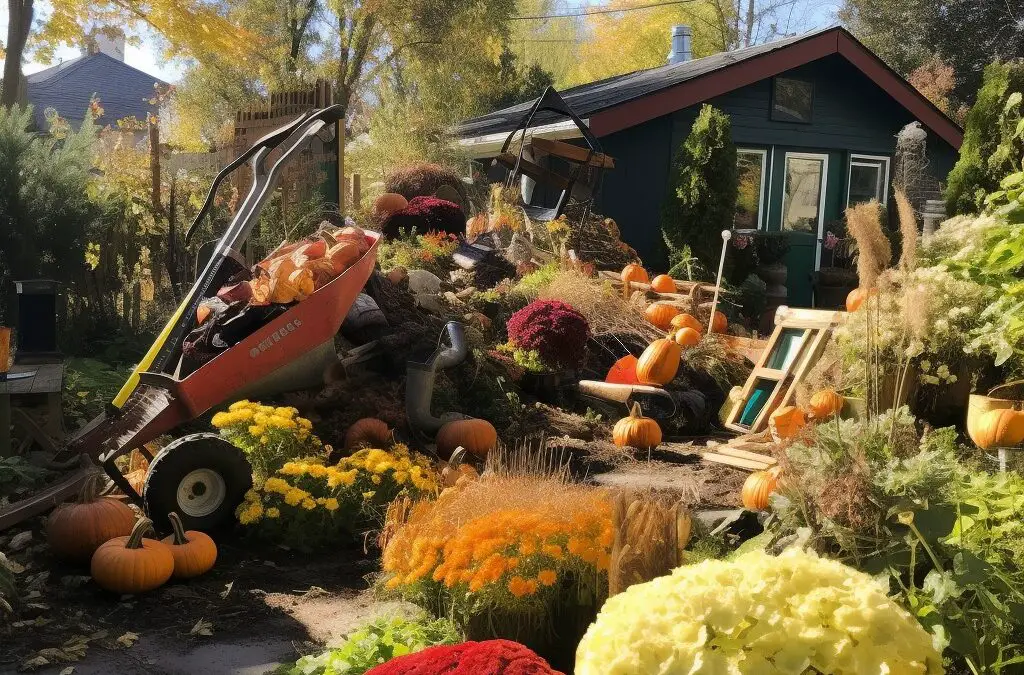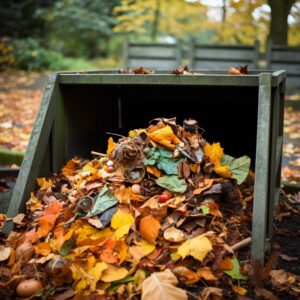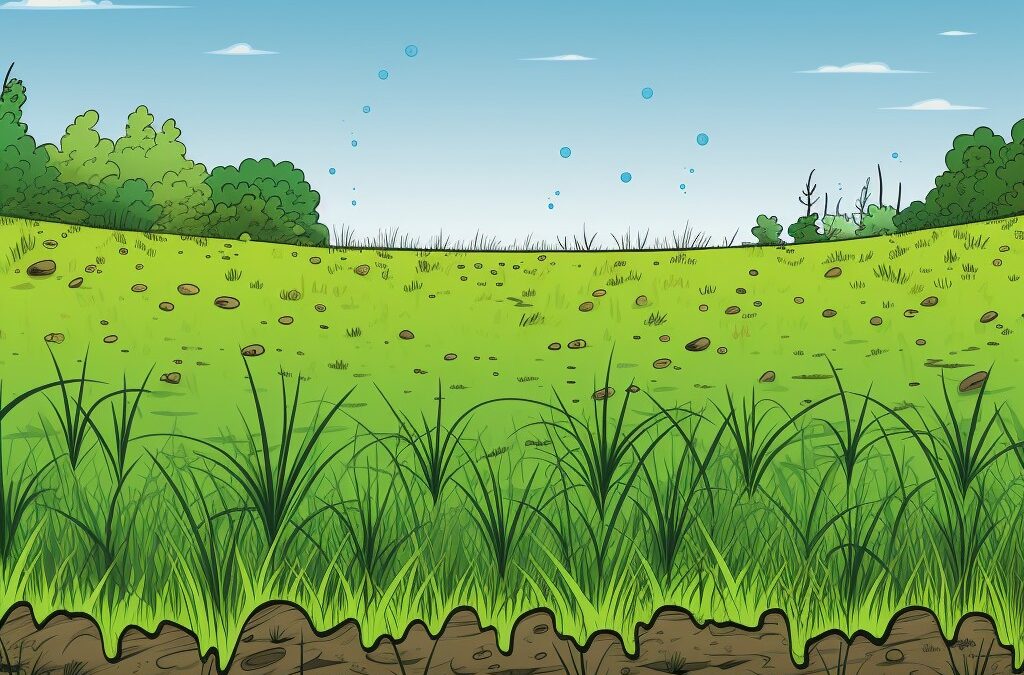
Fall Garden Cleanup: Because Let’s Be Real, Your Garden is a Hot Mess
Introduction
As a single mom and the voice behind Mom Versus the World, the fall garden cleanup has been my jam the last few years. The crisp air, the fiery foliage, and the sweet promise of putting my chaotic garden to rest. But let’s face it, fall garden cleanup is the unsung hero that paves the way for that springtime garden glow-up.
As we dive into the fall cleanup, there’s a smorgasbord of tasks awaiting us. From the leafy avalanche to the perennial pruning party and the ever-important defense against those pesky winter pests. It might sound overwhelming, but trust me, with a sprinkle of planning and a dash of elbow grease, it’s a transformative ritual that’s oddly satisfying.
In this guide, I’ll spill the tea on my fall garden cleanup escapades. We’ll chat about the perennials that need a little TLC and how to prep your green oasis for its winter slumber. So, pour yourself a drink (or a mocktail, if you’re on my wavelength) and let’s dive into the dirt.
Key Takeaways
- Fall garden cleanup is the gateway to a flourishing spring garden.
- From leaf management to perennial pampering, the cleanup is a mixed bag of tasks.
- A sprinkle of planning can turn the daunting cleanup into a rewarding ritual.
The Fall Garden Cleanup: DubG’s Deep Dive
Being the face of Mom Versus The World has taught me a thing or two about rolling with the punches, and fall garden cleanup is no exception. It’s a dance that requires finesse, but with some insider tips, you can waltz through it.
Firstly, let’s address the leafy elephant in the room. Raking leaves might seem like a Sisyphean task, but here’s a plot twist: some leaves are actually your garden’s BFF. That’s right, they offer a cozy blanket for overwintering critters and, when mulched, become a nutrient-packed treat for your soil. Just remember, moderation is key. A leaf carpet is chic, but a leaf mountain? Not so much.
Now, let’s talk compost. Fall is your golden ticket to start that compost pile you’ve been daydreaming about. It’s like a garden smoothie—a blend of “brown” leaves and “green” goodies that decompose to create garden gold. And for my fellow perennial lovers, resist the urge to give them a drastic haircut. Many of our buzzy friends, like bees and butterflies, cozy up in those stems for winter.
Vegetable gardeners, listen up! Clear out any sickly plants and decomposing debris. We don’t want any uninvited pests crashing our spring garden party. And while you’re at it, give your soil a protective mulch blanket or consider sowing a cover crop.
A rookie mistake I’ve made? Mowing my lawn too short. It’s like giving your lawn a buzz cut when all it wanted was a trim. Keep those mower blades high for the season’s final cut. And for those with a penchant for bulbs, fall is your planting playground. Daffodils, crocuses, and grape hyacinths are not only a treat for the eyes but also an early nectar source for our bee buddies.
To wrap it up, fall garden cleanup is more than just a chore; it’s a labor of love. With these tips in your arsenal, you’re set to strike that perfect balance, making both your back and your garden thank you. Cheers to a fabulous fall cleanup!
Mom Versus Leaves: The Leafy Showdown
Every fall, it feels like me (DubG) versus a gazillion leaves. The battle is real, folks, but the silver lining was that my arms and core became amazingly sculpted last year because my ex refused to let me borrow his leaf blower and steel rake. . So this year, I’m flipping the script; I’m harnessing the power of fallen leaves.
Composting the Fallen: DubG’s Green Gold Recipe
Composting is the garden magic we all need. If you’re not turning those fallen leaves into compost gold, you’re missing out. This season, I’m championing the compost cause. By layering “brown” leaves with “green” materials, I’m crafting a nutrient-rich concoction that’s pure garden elixir.
But wait, there’s more to leaves than just compost. Strategic leaf piles can be nature’s insulators, offering refuge to critters and pollinators bracing for winter. However, a word of caution for my fellow lawn lovers: don’t let those leaves smother your grass. A leafy sprinkle? Fabulous. A leafy avalanche? Not so chic.
In my past life, I might have banished all fallen leaves to the dump. But this year, I’m embracing their potential. From composting to crafting critter-friendly nooks, I’m turning the leafy onslaught into a garden win.
The Green Carpet Chronicles: DubG’s Lawn Lore
Juggling life as a single mom and the brains behind Mom Versus the World has given me a unique perspective on garden care. Fall is our cue to prep and pamper our gardens for the seasons ahead. Whether it’s sharpening those mower blades or feeding our lawns with nutrient love, I’m here to guide you through the green carpet chronicles of fall.
Mower Blade Massacre: DubG’s Lawn Lessons
Before Jack Frost starts nipping at your nose, it’s crucial to give your lawn that final, loving mow. But hold up! Before you rev up that mower, ensure that the blade is as sharp as my wit. A dull blade is like a bad breakup—it tears up the grass, leaving it vulnerable to all sorts of drama. I learned this the hard way, and let’s just say my lawn had a rough patch (literally). So, this season, I’m on top of my game, sharpening that blade for a pristine cut.
Nutrient Nourishment: Feed Your Lawn Like DubG Feeds Her Soul
Fall is the season of pumpkin spice and lawn nourishment. As the “Lawn Care Nut” preaches, it’s the time when cool-season grasses, like Kentucky bluegrass and ryegrasses, are gearing up for their winter siesta. So, I’m treating my lawn to a spa day, pampering it with Milorganite, and ensuring it wakes up next spring looking fabulous.
Weeding Out the Unwanted: DubG’s Garden Gatekeeping
Fall is also the season when those uninvited guests, like annual bluegrass and hairy bittercress, decide to crash the party. To keep these pesky intruders at bay, I’m rolling out the red carpet for prodiamine. But a word of caution: prodiamine is a bit exclusive and doesn’t let grass seeds grow. So, if you’re planning a lawn expansion, maybe skip the prodiamine this season.
And speaking of gatekeeping, if your lawn is already lush and thick, there’s no need to invite more seeds. Play defense, weed out the party crashers, and if your lawn looks a bit sparse, give it a Milorganite boost.
Perennial Pruning Party: DubG’s Garden Soiree
Being a single mom, author, and garden enthusiast, I’ve mastered the art of multitasking. And one task that’s non-negotiable? Keeping my perennial garden on point. The secret sauce? Deadheading those tired blossoms. It’s like giving your garden a facelift, ensuring it’s always ready for its close-up.
Trimming Time: DubG’s Guide to Garden Glam
Deadheading isn’t just a summer fling; it’s a season-long commitment. When is the best time to snip? When the flower starts looking like it partied a bit too hard,. The frequency of your deadheading dates depends on the flower’s stamina, which can vary from a one-night stand to a weeks-long affair. And just like dating, weather plays a role. A cool, rainy summer means your blooms will stick around longer, but a hot, dry spell? They’ll ghost you.
Choosing where to make that cut can be as confusing as choosing a Netflix show on a Friday night. But here’s the gist: prune the tired flowers and stems back to where a fresh bud or flower is waiting in the wings. If no new bloom is in sight, take it back to a leaf.
Deadheading Drama: DubG’s Blooming Chronicles
Many perennials, like the diva Shasta daisy, bloom even brighter with some deadheading love. And while deadheading can be therapeutic for some, for others, it’s a chore. My pro tip? Make it a daily ritual. A little snip here and there can extend your garden’s blooming season, making it the envy of the neighborhood.
And for my fellow garden enthusiasts, consider hosting a “Perennial Pruning Party.” Grab some friends, a bottle of wine, and make it a group activity. Trust me, it’s way more fun than flying solo. And while you’re at it, give your soil some TLC with compost and mulch. I’ve skipped this step before, and let’s just say my garden wasn’t pleased.
The Vegetable Vendetta: DubG’s Garden Grind
Being the voice behind Mom Versus The World, I’ve had my fair share of garden battles. Fall is the time to bid adieu to our green buddies and prep for winter. Here, I’ll spill the beans (pun intended) on my fall vegetable garden cleanup and sprinkle in some wisdom for the chilly months ahead.
Harvesting Havoc: DubG’s Garden Glow-Up
Kickstart your fall cleanup by bidding farewell to plant supports like bean stakes and tomato cages. A lesson from my playbook: clean them thoroughly before their winter hibernation. One year, I played it lazy, and my tomato cages turned into rusty relics. Now, I give them a thorough wipe-down or a bleach-water spa treatment to fend off diseases.
Next on the agenda is clearing out the garden beds. This includes the good, the bad, and the ugly—healthy plants, diseased ones, and old veggies. Healthy plant material gets a ticket to the compost pile, while the sick ones get the boot. Trust me, you don’t want last year’s drama to resurface next spring.
In conclusion, fall garden cleanup is like a therapy session for your garden. It’s a time to reflect, rejuvenate, and prep for the future. With these tips, you’ll not only have a garden that’s ready to face the winter but one that’ll bloom brighter come spring. Cheers to a fabulous fall and a garden that’s always on fire!
Planting the New Recruits: DubG’s Garden Bootcamp
After the grand farewell to the old plants, it’s time to roll out the red carpet for the new recruits. I usually pamper my soil with compost, manure, or other fancy fertilizers. It’s like giving the soil a spa day, rejuvenating it with nutrients and improving its texture. And if you’re feeling a bit adventurous, consider planting a winter cover crop like rye or clover. These crops are like the bouncers of the garden world, preventing soil erosion and adding some organic flair.
Timing is everything, darling. Start your garden’s winter prep right after the first frost sends those annuals packing. But if you spot plants throwing in the towel early, feel free to jumpstart your fall cleanup. As a single mom with a schedule tighter than my jeans after Thanksgiving, I always aim to be ahead of the game.
The Invasion of Insects: DubG’s Garden Horror Story
Every fall, as I gear up for my garden’s grand cleanup, I brace myself for the insect invasion. While some bugs are the life of the party, others are total party crashers.
Aphids, those tiny green menaces, have a knack for crashing my garden party. They’re like those clingy exes, sucking the life out of my plants. My go-to defense? Insecticidal soap or neem oil. But a word of caution: these can be a buzzkill for good bugs like ladybugs.
Then there are the sneaky spider mites. These tiny troublemakers are hard to spot, but their drama is unmistakable: yellowing leaves and spiderweb decor. A strong water spray is my weapon of choice, and sometimes I call in the big guns: predatory mites.
But remember, not all bugs are bad news. Some, like ladybugs and praying mantises, are the unsung heroes, keeping those pests in check. So, before you go all Rambo on the bugs, remember that some are on your side.
The Mulch Madness: DubG’s Garden Makeover
Fall’s here, and it’s makeover time for the garden. Mulching is like giving your garden a fresh coat of makeup. It not only beautifies but also shields your plants from winter’s icy stare.
This year, I’m going all out. I’ve had my share of mulching mishaps in the past, but this time, I’m armed with knowledge and a truckload of mulch. Choosing the right mulch is key. Some, like wood chips, can be drama queens, while others, like straw, can attract unwanted guests.
The Compost Conspiracy: DubG’s Garden Whodunit
Every year, I feel like there’s a plot against compost. I mean, I put in all this effort, and the pile just sits there, mocking me. But this year, I’m cracking the compost code.
Sunlight is the secret ingredient. Too much shade and the compost plays hard to get. And those leaves? Shred them before adding them to the pile. Trust me, it speeds up the process.
The Battle of the Bulbs: DubG’s Garden Showdown
Planting bulbs in the fall feels like a game of strategy. And let’s be real, sometimes the bulbs play hard to get. But with a bit of prep and some TLC, you can set the stage for a springtime spectacle.
In the past, I’ve been a bit casual with my bulb planting. Dig a hole, drop the bulb, and hope for a spring miracle. But now, I’m all about that prep life. Enriching the soil, planting at the right depth, and choosing the right bulbs are all part of the game plan.
Daffodils are my go-to because they’re not just pretty; they’re also deer-resistant. Tulips are gorgeous but watch out; they’re like candy for squirrels and we have psycho squirrels around here, no joke. And for that early spring pop of color, crocuses and hyacinths are my top picks.
So, as I gear up for this year’s Battle of the Bulbs, I’m armed with knowledge, determination, and a vision to one day have the best garden in the neighborhood. Right now, my kids will be the first to tell you that our house is number two.
The War Against Wildlife: DubG’s Garden Chronicles
Ah, the joys of gardening. Birds serenading, butterflies fluttering, and… wait, did that squirrel just make off with my last tomato? Welcome to my world, where the garden isn’t just a place of beauty but a battleground against nature’s little marauders.
Bird netting? Check. It’s like the VIP rope at a club, keeping the uninvited out. It’s amusing watching birds try to figure out this garden enigma. Deer spray? It’s like the perfume you wear that some people love and others don’t. And scarecrows? More like garden decor than an actual deterrent. As for my pond, it’s not a froggy free-for-all. A good net keeps those amphibian party crashers at bay.
But let’s talk raccoons. Those masked bandits once turned my shed into their personal Airbnb. It was not a five-star experience for me.
The Seed Struggle: DubG’s Garden Dilemmas
Fall cleanup is like trying to organize a toddler’s playroom while they’re still playing. Seeds everywhere, leaves carpeting the ground, and me, trying to find a balance between a tidy garden and a bird buffet.
Those seeds? They’re not just garden leftovers; they’re a gourmet meal for our feathered friends. And the leaves? Nature’s blanket, offering shelter to critters and enriching the soil. So, while I might be tempted to rake and bag, I’ve learned to embrace the beautiful chaos.
And speaking of chaos, let’s talk about brush piles. They’re like the condos of the garden world, offering shelter to birds and other wildlife. Plus, it’s a great way to recycle those fallen branches.
The Shrub Showdown: DubG’s Garden Drama
Every year, as fall approaches, my garden turns into a scene from a reality TV show, “Garden’s Got Talent.” The contestants? My shrubs, each vying for the spotlight.
The burning bush, with its fiery fall foliage, is like the diva of the garden. Gorgeous, but high maintenance. Then there’s the boxwood, the reliable friend who’s always there. I thought there was no drama, until this year one of them got a bug, so we had to do some fast-thinking recon, but the battle has been won!!!
So, how do I keep the peace in this garden showdown? Strategic pruning, a touch of mulch, and a watchful eye for pests. And when winter’s icy fingers reach out, a little protection goes a long way.
In the end, every shrub has its moment to shine. And me? I’m just a marksman with my sniper insecticide rifle, waiting for the next foolish little pest to try me for size.
The Plant Protection Program
As a gardener, I know that the fall season is the perfect time to start thinking about protecting my plants. The Plant Protection Program is my go-to guide for ensuring that my plants stay healthy and strong throughout the colder months.
First and foremost, I make sure to remove any dead or diseased plants from my garden beds. This not only helps prevent the spread of disease, but it also frees up space for new plantings. I also take the time to prune any overgrown shrubs or trees, which helps promote healthy growth in the spring.
When it comes to planting new trees and shrubs, I always make sure to choose varieties that are hardy enough to withstand the cold winter months. I also add a layer of mulch around the base of each plant to help insulate the roots and protect them from freezing temperatures.
Cover crops are another important part of my plant protection program. These crops help prevent soil erosion and add valuable nutrients to the soil, which can help improve the health of my plants in the long run. This year, I plan on planting a mix of rye, clover, and vetch to help keep my soil healthy and fertile.
Finally, I always make sure to provide adequate support for my plants. This includes staking tall plants and using cages to support vines and other climbing plants. By providing the right support, I can help prevent damage from high winds and heavy snowfall.
In the past, I’ve made plenty of mistakes when it comes to fall garden cleanup. I’ve neglected to remove dead plants, failed to provide adequate support for my plants, and even planted the wrong varieties for my climate. But by following the Plant Protection Program, I’ve been able to avoid these mistakes and keep my garden healthy and thriving year after year.
So let’s review…
- Step 1: The Great Garden Clean-Up. Dead or diseased plants? Out you go! It’s like the Marie Kondo method but for plants. If they don’t spark joy (or life), they’re gone.
- Step 2: Pruning Party. Overgrown shrubs and trees get a little trim, ensuring they strut their stuff come spring.
- Step 3: Mulch Madness. A cozy blanket of mulch around my plants keeps their roots snug and warm. It’s like giving them a little hug.
- Step 4: Cover Crop Carnival. Rye, clover, vetch—oh my! These crops are the unsung heroes, enriching my soil and prepping it for next year’s garden gala.
- Step 5: Support Squad. Stakes, cages, and other supports ensure my plants stand tall, come wind or snow.
The Checklist Challenge: DubG’s Fall Garden To-Do List
Every fall, I face the ultimate challenge: the garden checklist. It’s like an obstacle course, but instead of mud and ropes, there’s soil and plants.
- Clear Out: Dead plants, you’ve had your time. Make way for the new!
- Prune: It’s like giving my plants a fresh new haircut.
- Weed War: Hand-to-weed combat. It’s a thing.
- Divide & Conquer: Some plants just need their own space.
- Soil Spa Day: A little compost, some manure, and voila! Happy soil.
The key? Take it one step at a time. And maybe, just maybe, with a glass of wine in hand.
Conclusion
Gardening, like life, is full of ups and downs. But with a little preparation and a lot of love, we can weather any storm. As the author of Mom Versus The World, I’ve faced my fair share of challenges, both in the garden and out. But with every fall cleanup, I’m reminded of the beauty of new beginnings. So here’s to fresh starts, happy plants, and a garden that’s ready to face whatever Mother Nature has in store. Cheers!

